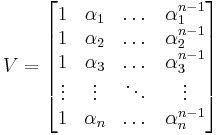Alternant matrix
In linear algebra, an alternant matrix, is a matrix with a particular structure, in which successive columns have a particular function applied to their entries. An alternant determinant is the determinant of an alternant matrix. Such a matrix of size m × n matrix may be written out as
or more succinctly
for all indices i and j. (Some authors use the transpose of the above matrix.)
Examples of alternant matrices include Vandermonde matrices, for which  and Moore matrices for which
and Moore matrices for which  .
.
If  and the
and the  functions are all polynomials we have some additional results: if
functions are all polynomials we have some additional results: if  for any
for any  then the determinant of any alternant matrix is zero (as a row is then repeated), thus
then the determinant of any alternant matrix is zero (as a row is then repeated), thus  divides the determinant for all
divides the determinant for all  . As such, if we take
. As such, if we take
(a Vandermonde matrix) then  divides such polynomial alternant determinants. The ratio
divides such polynomial alternant determinants. The ratio  is called a bialternant. In the case where each function
is called a bialternant. In the case where each function  , this forms the classical definition of the Schur polynomials.
, this forms the classical definition of the Schur polynomials.
Alternant matrices are used in coding theory in the construction of alternant codes.
See also
References
- Thomas Muir (1960). A treatise on the theory of determinants. Dover Publications. pp. 321–363.
- A. C. Aitken (1956). Determinants and Matrices. Oliver and Boyd Ltd. pp. 111–123.
- Richard P. Stanley (1999). Enumerative Combinatorics. Cambridge University Press. pp. 334–342.


